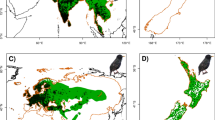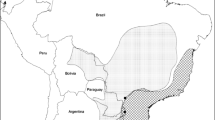Abstract
Wedelia trilobata (L.) Hitchc., an ornamental groundcover plant introduced to areas around the world from Central America, has become invasive in many regions. To increase understanding of its geographic distribution and potential extent of spread, two presence-only niche-based modeling approaches (Maxent and GARP) were employed to create models based on occurrence records from its: (1) native range only and (2) full range (native and invasive). Models were then projected globally to identify areas vulnerable to W. trilobata invasion. W. trilobata prefers hot and humid environments and can occur in areas with different environmental conditions than experienced in its native range. Based on native and full occurrence points, GARP and Maxent models produced consistent distributional maps of W. trilobata, although Maxent model results were more conservative. When used to estimate the global invasive distribution of the species, both modeling approaches projected the species to occur in Africa. The GARP full model succeeded in predicting the known occurrences in Australia, while the other models failed to identify favorable habitats in this region. Given the rapid spread of W. trilobata and the serious risk of this species poses to local ecosystems, practical strategies to prevent the establishment and expansion of this species should be sought.






Similar content being viewed by others
References
Anderson RP, Lew D, Peterson AT (2003) Evaluating predictive models of species’ distributions: criteria for selecting optimal models. Ecol Model 162:211–232
Batianoff GN, Franks AJ (1997) Invasion of sandy beachfronts by ornamental plant species in Queensland. Plant Prot Q 12:180–186
Broennimann O, Guisan A (2008) Predicting current and future biological invasions: both native and invaded ranges matter. Biol Lett 4:585–589
Broennimann O, Treier UA, Müller-Schärer H, Thuiller W, Peterson AT, Guisan A (2007) Evidence of climatic niche shift during biological invasion. Ecol Lett 10:701–709
Clements DR, DiTommaso A (2011) Climate change and weed adaptation: can evolution of invasive plants lead to greater range expansion than forecasted? Weed Res 51:227–240
Costa GC, Schlupp I (2010) Biogeography of the Amazon molly: ecological niche and range limits of an asexual hybrid species. Global Ecol Biogeogr 19:442–451
Csurhes S, Edwards R (1998) National weeds program: potential environmental weeds in Australia—candidate species for preventative control. National Parks and Wildlife Biodiversity Group, Environment Australia, Canberra
De Meyer M, Robertson MP, Mansell MW, Ekesi S, Tsuruta K, Mwaiko W, Vayssières JF, Peterson AT (2010) Ecological niche and potential geographic distribution of the invasive fruit fly Bactrocera invadens (Diptera, Tephritidae). B Entomol Res 100:35–48
Elith J et al (2006) Novel methods improve prediction of species’ distributions from occurrence data. Ecography 29:129–151
Estrada-Peña A, Pegram RG, Barré N, Venzal J (2007) Using invaded range data to model the climate suitability for Amblyomma variegatum (Acari: Ixodidae) in the New World. Exp Appl Acarol 41:203–214
FLEPPC (2014) Florida exotic pest plant council invasive plant lists. http://www.fleppc.org/list/list.htm. Accessed 5 Feb 2015
Giovanelli JGR, de Siqueira MF, Haddad CFB, Alexandrino J (2010) Modeling a spatially restricted distribution in the neotropics: how the size of calibration area affects the performance of five presence-only methods. Ecol Model 221:215–224
Guisan A, Thuiller W (2005) Predicting species distribution: offering more than simple habitat models. Ecol Lett 8:993–1009
Heikkinen RK, Marmion M, Luoto M (2012) Does the interpolation accuracy of species distribution models come at the expense of transferability? Ecography 35:276–288
Henderson L (2001) Alien weeds and invasive plants. Plant Protection Research Institute Handbook No 12. Plant Protection Research Institute, Agricultural Research Council, South Africa. pp 58
Hernandez PA, Graham CH, Master LL, Albert DL (2006) The effect of sample size and species characteristics on performance of different species distribution modeling methods. Ecography 29:773–785
Hijmans R, Guarino L, Mathur P, Jarvis A (2002) DIVA-GIS: geographic information system for biodiversity research manual. International Potato Center, Lima
Hijmans RJ, Cameron SE, Parra JL, Jones PG, Jarvis A (2005) Very high resolution interpolated climate surfaces for global land areas. Int J Climatol 25:1965–1978
Hossain ABME, Hassan MA (2005) Wedelia trilobata (l.) AS Hitchc. (Asteraceae)—a new record for Bangladesh. Bangl J of Plant Taxon 12:63–65
Hutchinson GE (1957) Concluding remarks. Cold Spring Harb Sym 22:415–427
Hyde M, Wursten B, Ballings P, Palgrave MC (2014) Flora of Zimbabwe: species information: Sphagneticola trilobata. http://www.zimbabweflora.co.zw/speciesdata/species.php?species_id=160400. Accessed 10 Nov 2014
Koheil MA (2000) Study of the essential oil of the flower-heads of Wedelia trilobata (L.) Hitch. Al-Azhar J Pharm Sci 26:288–293
Kottek M, Grieser J, Beck C, Rudolf B, Rubel F (2006) World Map of the Köppen–Geiger climate classification updated. MetZe 15:259–263
Kühn I, Klotz S (2003) The alien flora of Germany-basics from a new German database. In: LE Child, Brock JH, Brundu G, Prach K, Pyšek P, Wade PM, Williamson M (eds) Plant invasions: ecological threats and management solutions. Backhuys, Leiden, pp 89–100
Lambdon et al (2008) Alien flora of Europe: species diversity, temporal trends, geographical patterns and research needs. Preslia 80:101–149
Larson ER, Olden JD, Usio N (2010) Decoupled conservatism of Grinnellian and Eltonian niches in an invasive arthropod. Ecosphere 1:art16
Liogier AH, Martorell LF (2000) Flora of puerto rico and adjacent islands: a systematic synopsis. Ed. de la Univ
Lowe S, Browne M, Boudjelas S, Poorter MD (2000) 100 of the World’s worst invasive alien species: a selection from the global invasive species database. The IUCN Invasive Species Specialist Group (ISSG), pp 12
Mau-Crimmins TM, Schussman HR, Geiger EL (2006) Can the invaded range of a species be predicted sufficiently using only native-range data? Ecol Model 193:736–746
McConnell J, Muniappan R (1991) Introduced ornamental plants that have become weeds on Guam. Micronesia (Suppl 3):47–49
Nie C, Luo S, Zeng R, Mo M, Li H, Lin C (2004) Allelopathic potential of Wedelia trilobata L.: effects on germination, growth and physiological parameters of rice. Acta Agron Sin 30:942–946
Pearson RG, Raxworthy CJ, Nakamura M, Townsend Peterson A (2007) Predicting species distributions from small numbers of occurrence records: a test case using cryptic geckos in Madagascar. J Biogeogr 34:102–117
Peterson AT, Papeş M, Soberón J (2008) Rethinking receiver operating characteristic analysis applications in ecological niche modeling. Ecol Model 213:63–72
Phillips SJ (2008) Transferability, sample selection bias and background data in presence-only modelling: a response to Peterson et al. (2007). Ecography 31:272–278
Phillips SJ, Dudík M (2008) Modeling of species distributions with Maxent: new extensions and a comprehensive evaluation. Ecography 31:161–175
Phillips SJ, Anderson RP, Schapire RE (2006) Maximum entropy modeling of species geographic distributions. Ecol Model 190:231–259
Raes N, ter Steege H (2007) A null-model for significance testing of presence-only species distribution models. Ecography 30:727–736
Raxworthy CJ, Martinez-Meyer E, Horning N, Nussbaum RA, Schneider GE, Ortega-Huerta MA, Townsend Peterson A (2003) Predicting distributions of known and unknown reptile species in Madagascar. Nature 426:837–841
Reichard SH, White P (2001) Horticulture as a pathway of invasive plant introductions in the United States: most invasive plants have been introduced for horticultural use by nurseries, botanical gardens, and individuals. Bioscience 51:103–113
Rodda GH, Jarnevich CS, Reed RN (2011) Challenges in identifying sites climatically matched to the native ranges of animal invaders. PLoS One 6:e14670
Romesburg HC (1985) Exploring, confirming, and randomization tests. Comput Geosci 11:19–37
Sinclair SJ, White MD, Newell GR (2010) How useful are species distribution models for managing biodiversity under future climates. Ecol Soc 15:8
Song L, Wu J, Li C, Li F, Peng S, Chen B (2009) Different responses of invasive and native species to elevated CO2 concentration. Acta Oecol 35:128–135
Song L, Chow WS, Sun L, Li C, Peng C (2010) Acclimation of photosystem II to high temperature in two Wedelia species from different geographical origins: implications for biological invasions upon global warming. J Exp Bot 61:4087–4096
Stockwell DRB, Noble IR (1992) Induction of sets of rules from animal distribution data: a robust and informative method of data analysis. Math Comput Simulat 33:385–390
Stockwell D, Peterson AT (2003) Comparison of resolution of methods used in mapping biodiversity patterns from point-occurrence data. Ecol Indic 3:213–221
Terribile LC, Diniz-Filho JAF (2010) How many studies are necessary to compare niche-based models for geographic distributions? Inductive reasoning may fail at the end. Braz J Biol 70:263–269
Thaman RR (1999) Wedelia trilobata: daisy invader of the Pacific Islands. IAS Tech Rep 99. Institute of Applied Science, University of the South Pacific, Suva, Fiji
Thompson GD, Robertson MP, Webber BL, Richardson DM, Le Roux JJ, Wilson JRU (2011) Predicting the subspecific identity of invasive species using distribution models: Acacia saligna as an example. Divers Distrib 17:1001–1014
Thuiller W, Richardson DM, PyŠEk P, Midgley GF, Hughes GO, Rouget M (2005) Niche-based modelling as a tool for predicting the risk of alien plant invasions at a global scale. Glob Change Biol 11:2234–2250
Thuiller W et al (2008) Predicting global change impacts on plant species’ distributions: future challenges. Perspect Plant Ecol Evol Syst 9:137–152
Townsend Peterson A, Papeş M, Eaton M (2007) Transferability and model evaluation in ecological niche modeling: a comparison of GARP and Maxent. Ecography 30:550–560
Tsai CH, Lin FM, Yang YC, Lee MT, Cha TL, Wu GJ, Hsieh SC, Hsiao PW (2009) Herbal extract of Wedelia chinensis attenuates androgen receptor activity and orthotopic growth of prostate cancer in nude mice. Clin Cancer Res 15:5435–5444
Wagner WL, Herbst DR, Sohmer SH (1990) Manual of the flowering plants of Hawai’i. University of Hawaii Press and Bishop Museum Press, Honolulu
Welk E (2004) Constraints in range predictions of invasive plant species due to non-equilibrium distribution patterns: purple loosestrife (Lythrum salicaria) in North America. Ecol Model 179:551–567
Wu YQ, Hu YJ, Chen JN (2005) Reproductive characteristics of alien plant Wedelia trilobata. Acta Sci Nat Univ Sunyatseni 44:93–96
Acknowledgments
We are grateful to the Key Laboratory of Ecological Agriculture of the Ministry of Agriculture of China and the Key Laboratory of Agroecology and Rural Environment of Guangdong Regular Higher Education Institutions, South China Agricultural University for fostering research on this topic. This work was supported by the National Natural Science Foundation of China (No. U1131006, 31300405), the Doctoral Fund of the Ministry of Education of China (No. 20124404110009). We thank Rongkui Han and anonymous reviewers for providing helpful comments on earlier versions of this manuscript.
Author information
Authors and Affiliations
Corresponding author
Rights and permissions
About this article
Cite this article
Qin, Z., Zhang, Je., DiTommaso, A. et al. Predicting invasions of Wedelia trilobata (L.) Hitchc. with Maxent and GARP models. J Plant Res 128, 763–775 (2015). https://doi.org/10.1007/s10265-015-0738-3
Received:
Accepted:
Published:
Issue Date:
DOI: https://doi.org/10.1007/s10265-015-0738-3




